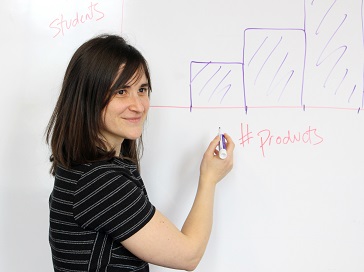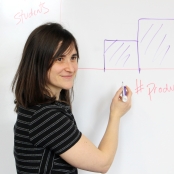Engaging high school students in environmental health: A young scientist makes an impact
 You know the saying, “healthy habits start young.” That’s why Jennie Liss Ohayon is excited about a new opportunity to engage high school students in learning about environmental health—specifically the health risks associated with harmful chemicals in everyday products. The goal of the new project is to help students reduce their toxic exposures while providing them with leadership skills to promote healthier environments at home and in their communities.
You know the saying, “healthy habits start young.” That’s why Jennie Liss Ohayon is excited about a new opportunity to engage high school students in learning about environmental health—specifically the health risks associated with harmful chemicals in everyday products. The goal of the new project is to help students reduce their toxic exposures while providing them with leadership skills to promote healthier environments at home and in their communities.
“Students are a powerful voice,” says Ohayon, a postdoctoral research fellow at Silent Spring Institute. “They’re also the leaders, decision-makers, and educators of tomorrow. By raising awareness of how chemicals in consumer products impact health and disease, I hope to inspire students not only to lead healthier lives but also be proactive in advocating for change.”
Working in collaboration with the Massachusetts Breast Cancer Coalition (MBCC), Ohayon developed a new high school curriculum module on environmental health, as part of MBCC’s "Let’s Talk Prevention" educational program. Now, thanks to a grant from the Toxics Use Reduction Institute, she is introducing the curriculum to six schools in Massachusetts this year, engaging with more than 275 students.
Early exposure
Ohayon first began working with high school students while doing her PhD at the University of California, Santa Cruz. With funding from the National Science Foundation, she developed hands-on environmental science curriculum for students in a rural Latino community in California.
She taught them how to make biodiesel using waste vegetable oil the students collected from restaurants in the area. In another unit, she led the students through an energy audit of their school and helped them find ways to their reduce energy usage. “At one point, I even had them riding stationary bikes, converting mechanical energy into electricity to power a light bulb,” says Ohayon.
Now, she’s applying the same skills she learned during her graduate work to teaching students about environmental health. The new curriculum focuses on a class of chemicals called endocrine disrupting chemicals (or EDCs). These are chemicals that interfere with the body’s hormones and include things like BPA in cans and bottles, parabens in shampoos and lotions, and phthalates in plastics and vinyl products.
The curriculum is based in large part on research by Silent Spring, which shows that EDCs escape from products and accumulate in indoor air and dust, and that consumer products are a significant contributor to chemical exposures in the general population. “The work we are doing here is especially relevant to teenagers,” says Ohayon. “This is a vulnerable period in life when their bodies are susceptible to environmental exposures. So, it’s a really important population to work with. That, and they’re a lot fun!”
A hands-on experience
In January, speaking to a group of sophomores and juniors at Boston Latin Academy, Ohayon begins the class with an overview of the body’s endocrine system, what are EDCs, how they impact health, and where they’re found. She then gives the students a survey to take home to record the different products they use. The students will later graph their results and look for common sources of exposure.
“It's been really valuable for the students to hear directly from a scientist who is passionate about this work,” says MBCC's Program & Development Director Michelle Dixon. “Many students have never considered the links between their environment and their health, and this program helps them to think about disease prevention in a new way.”
Ohayon introduces the class to Silent Spring’s interactive mobile app called Detox Me, which offers easy tips on how to avoid harmful chemicals at home. Silent Spring's Jessica Helm, who created the app, then tracks the students' changes in behavior by looking at which tips they successfully adopt. “This generation has grown up with cell phones. They’ve never known a world without the Internet, so using a smartphone app is a very natural and effective way to engage them in learning,” she says.
The curriculum also connects the students with teen mentors from the University of California Berkeley’s Center for Environmental Research and Children’s Health (CERCH). Through a video stream, several mentors share their experiences participating in youth-led research projects and offer advice on how to work with advocacy groups and policymakers.
“We talk a lot about leadership, what it means, and the skills you need to create change in your communities,” says Ohayon. “These teen mentors are proof that young people’s voices matter and that they can make a difference, and it’s great to be able to share that message.”
Ohayon hopes for more programs where students work closely with teachers and administrators to create healthy and productive learning environments. A growing number of schools throughout the country have already begun making changes such as switching to green cleaning products or avoiding synthetic turf playing fields. “These are great initiatives and are often spearheaded by administrators or concerned parents,” she says. “But it’s important to also involve students and let them take the lead.”

Jennie Liss Ohayon, postdoctoral fellow at Silent Spring Institute